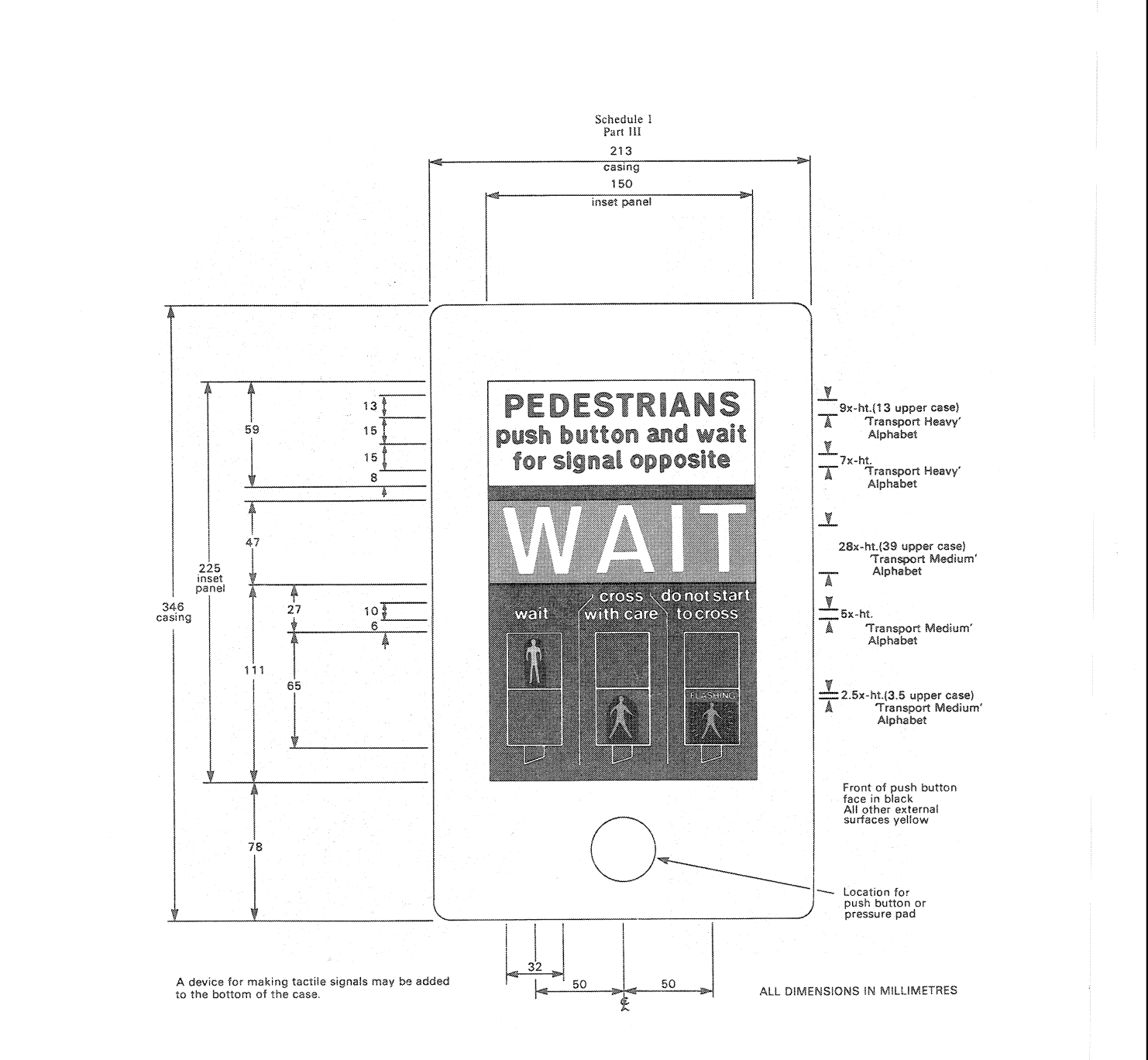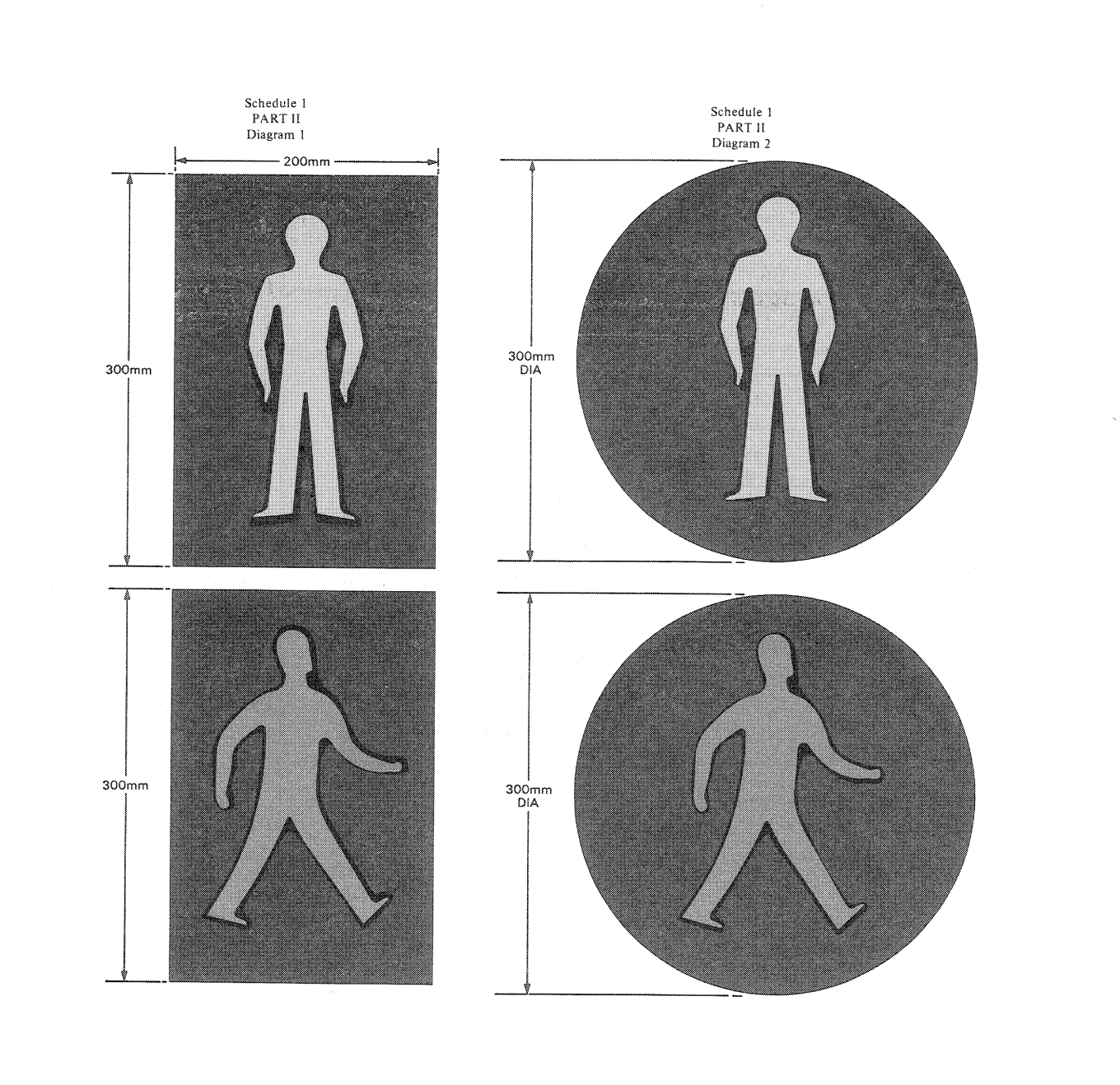Regulation 2(1)
SCHEDULE 1THE SIZE, COLOUR AND TYPE OF TRAFFIC SIGNS AT A “PELICAN” CROSSING
PART I
Traffic signs
1. The traffic signs which are to be placed at or near a crossing for the purpose of constituting it a “Pelican” crossing shall consist of a combination of–
(a)vehicular light signals;
(b)pedestrian light signals; and
(c)indicators for pedestrians,
of the size, colour and type prescribed by the following provisions of this Schedule, together with any additional traffic signs placed at or near the crossing pursuant to regulation 6.
Vehicular light signals
2. The vehicular light signals shall be as follows–
(a)three lights shall be used, one red, one amber, and one green;
(b)the lamps showing the aforesaid lights shall be arranged vertically, the lamp showing the red light being the uppermost and that showing the green light the lowermost;
(c)each lamp shall be separately illuminated and the effective diameter of the lens thereof shall be not less than 195 millimetres nor more than 220 millimetres;
(d)the height of the centre of the amber lens from the surface of the carriageway in the immediate vicinity shall, in the case of signals placed at the side of the carriageway or on a central reservation, be not less than 2.4 metres nor more than 4 metres and, in the case of signals placed elsewhere and over the carriageway, not less than 6.1 metres nor more than 9 metres;
(e)the centres of the lenses of adjacent lamps shall be not less than 305 millimetres nor more than 360 millimetres apart;
(f)the lamp showing the amber light shall be capable of showing a steady light or a flashing light such that it flashes at a rate of not less than 70 nor more than 90 flashes per minute; and
(g)no lettering or symbols shall be used upon the lens.
Pedestrian light signals
3.—(1) The pedestrian light signals shall be of the size, colour and type shown in the diagrams in Part II of this Schedule.
(2) The height of the lower edge of the container enclosing the light signals from the surface of the carriageway in the immediate vicinity shall be not less than 2.1 metres nor more than 2.6 metres.
(3) The said signals shall be so designed that–
(a)the red figure shown in the said diagrams can be internally illuminated by a steady light;
(b)the green figure shown in the said diagrams can be internally illuminated by a steady light or by a flashing light at a rate of not less than 70 nor more than 90 flashes per minute; and
(c)when one signal is illuminated the other signal is not illuminated.
(4) A device for emitting audible signals may be provided for use when the green figure is illuminated by a steady light.
Indicator for pedestrians
4.—(1) The indicator for pedestrians shall be of the size, colour and type shown in the diagram in Part III of this Schedule.
(2) The indicator for pedestrians shall be so designed and constructed that “WAIT” as shown on the diagram can be illuminated and that there is incorporated in the indicator a device, which may be a push button or pressure pad and which is hereinafter in this Schedule referred to as “a push button”, which can be used by pedestrians with the effect hereinafter described.
(3) The instruction for pedestrians shown in the diagram may be internally illuminated.
(4) A device for making tactile signals may be provided for use when the green figure shown in the diagram is illuminated by a steady light.
Sequence of signals
5.—(1) The vehicular light signals and pedestrian light signals and the indicators for pedestrians when they are placed at or near any crossing shall be so designed and constructed that–
(a)before the signals and indicators are operated by the pressing of a push button or as described in paragraph 6 of this Schedule the vehicular light signal shows a steady green light, the pedestrian light signal shows a red light, the word “WAIT” in the indicator for pedestrians is not illuminated, any device for making tactile signals is inactive, and any device for emitting audible signals is silent;
(b)when a push button is pressed–
(i)after the expiration of the vehicle period but before the vehicular light signals are showing a steady amber light, the signals and indicators, unless they are working as described in paragraph 6 of this Schedule, are caused to show lights in the sequences specified in descending order in column 1 in the case of vehicular light signals, in column 2 in the case of pedestrian light signals and in column 3 in the case of the indicators for pedestrians, of either Part IV or Part V of this Schedule;
(ii)when the vehicular light signals are showing a steady amber light or a red light when the signal to pedestrians shows a red or steady green light, there is no effect;
(iii)when the pedestrian light signals are showing a flashing green light, the word “WAIT” in each of the indicators for pedestrians is illuminated immediately and the signals and indicators are caused to show lights in the sequence specified in sub-paragraph (i) of this paragraph at the end of the next vehicle period; and
(iv)after the pedestrian light signals have ceased to show a flashing green light and before the end of the next vehicle period, the word “WAIT” in each of the indicators for pedestrians is illuminated immediately and the signals and indicators are caused to show lights in the sequence specified in sub-paragraph (i) of this paragraph at the end of the vehicle period;
(c)the periods during which lights are shown by the signals and the indicators, commence and terminate in relation to each other as shown in either Part IV or Part V of this Schedule as if each horizontal line therein represented one moment in time, subsequent moments occurring in descending order, but the distances between the horizontal lines do not represent the lengths of the periods during which the lights shown by the signals and the indicator are, or are not, lit.
(2) Where a device for emitting audible signals has been provided pursuant to paragraph 3(4) of this Schedule, it shall be so designed and constructed that a pulsed sound is emitted throughout every period when the pedestrian light signals are showing a steady green light, and at the same time the vehicular light signals are showing a red light, but only during such periods and at no other times, save that such a device need not operate during the hours of darkness.
(3) Where a device for making tactile signals has been provided pursuant to paragraph 4(4) of this Schedule, it shall be so designed and constructed that a regular movement perceptible to touch by pedestrians is made throughout every period when the pedestrian light signals are showing a steady green light, and at the same time the vehicular light signals are showing a red light, but only during such periods and at no other times.
(4) In this paragraph “vehicle period” means such period as may be fixed from time to time in relation to a “Pelican” crossing, which commences when the vehicular light signals cease to show a flashing amber light and during which the vehicular traffic light signals show a green light.
Operation by remote control
6. The vehicular light signals, pedestrian light signals, indicators for pedestrians, any device for making tactile signals, and any device for emitting audible signals, when they are placed at or near any crossing may also be so designed and constructed that they can by remote control be made to operate–
(a)as if a push button has been pressed; and
(b)so that the pressing of a push button has no effect, other than causing the word “WAIT” in each of the indicators for the pedestrians to be illuminated, until normal operation is resumed.
PART IVsequence of operation of vehicular and pedestrian light signals and indicator for pedestrians (but not the audible signals)
| Sequence of vehicular traffic light signals | Sequence of pedestrian signals | |
|---|---|---|
| Pedestrian light signals | Indicator for pedestrians | |
| (1) | (2) | (3) |
| Green light | Red light | The word “WAIT” is illuminated |
| Amber light | ||
| Red light | ||
| Green light | The word “WAIT” is not illuminated | |
| Flashing amber light | Flashing green light | The word “WAIT” is illuminated |
| Red light | ||
| Green light | ||
PART Valternative sequence of operation of vehicular and pedestrian light signals and indicator for pedestrians (but not the audible signals)
| Sequence of vehicular traffic light signals | Sequence of pedestrian signals | |
|---|---|---|
| Pedestrian light signals | Indicator for pedestrians | |
| (1) | (2) | (3) |
| Green light | Red light | The word “WAIT” is illuminated |
| Amber light | ||
| Red light | ||
| Green light | The word “WAIT” is not illuminated | |
| Flashing green light | The word “WAIT” is illuminated | |
| Flashing amber light | Flashing green light | The word “WAIT” is illuminated |
| Flashing amber light | Red light | |
| Green light | ||


